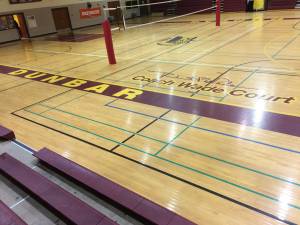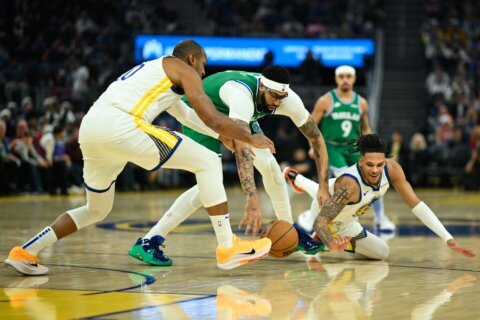BALTIMORE, Md. — On the northwest corner of North Central Avenue and Orleans Street, just a couple blocks to the east of Johns Hopkins Hospital, not far from Baltimore’s Inner Harbor, sits an unassuming maroon brick and glass building. Inside lies an equally understated gym, indistinguishable from any other public high school’s in America, save for the championship banner that hangs in the far corner and the name inscribed on the court itself, that of Bob Wade.
Wade guided the Paul Lawrence Dunbar High School Poets from a powerhouse to a legendary high school program that rates among the very best ever in American history. Dunbar’s 1981-82 and 1982-83 teams combined to go 59-0, the latter season culminating in a national championship.
Led by four future NBA players, they were an astonishing ensemble of talent, all from one city, all on one public high school team. Thirty-five years later, the tales of the Poets’ feats have inspired a book, and ESPN Films is in the early stages of producing a 30-for-30 on the team. While the air date for the film is not yet known, the book — Alejandro Danois’ “The Boys of Dunbar: A story of love, hope and basketball” — is out now. I recently spoke with Danois, a New York City native, about his inspiration for telling this particular story.
Growing up on the blacktop of a powerhouse basketball city, he and his friends were under the understandably mistaken impression that the Big Apple was also home to all the best teams. But that changed one day, setting in motion the idea that would eventually become his book.
“There was an older guy in our building who said, ‘Yeah, well, New York’s the best basketball city, but the best team I’ve ever seen is a high school team from Baltimore called Dunbar,’” Danois recalled.
The man mentioned Reggie Williams, the future Georgetown star that was considered to be the best prep player in the country that year.
“But the crazy thing is he’s not even the best player on his own team,” the man told Danois. “The best player is a five-foot midget, and his name is Buggsy.”
Buggsy would be none other than Tyrone “Muggsy” Bogues, the 14-year NBA veteran and shortest player in the history of the Association at just 5 foot 3 inches. Because of his stature, he was underestimated at every turn, even back at Dunbar. By Danois’ account, the chip with which Bogues played seemed to permeate to the entire team, which was always out to prove itself and the city of Baltimore to the rest of the country.

They shared a connection through their city that many of the powerhouse high school teams of today, with kids from all over the state or country, simply could never have.
“This was a team of guys that grew up together playing on milk crates in the back allies when the older guys would shoo them off the court,” said Danois. “Their parents knew one another. Bob Wade knew their families before they were born. They ate at the same dinner tables before they showed a hint of athletic promise … No one knew what they would become.”
In addition to Williams and Bogues, the Poets also featured future Georgetown Hoya and Washington Bullet David Wingate as well as Reggie Lewis, who would go on to star for the Boston Celtics until his tragic death from an undiagnosed heart condition at age 27 in 1993.
The depth of talent was undeniable, but it’s hard to imagine that the Poets would have achieved anywhere near the same measure of success without the guidance of Wade. Those who only know the coach from his disappointing stint at the University of Maryland may not realize Wade went an eye-popping 341-24 in his time leading Dunbar, and guided over 200 student-athletes to basketball and football scholarships.
“I think it’s unfair that people paint this portrait of him based on a two-and-a-half-year run at the University of Maryland,” said Danois. “To really judge what he accomplished as an educator, as a coach, and what he meant to youth and their development, you have to look at what he did at Dunbar High School in East Baltimore.”

Wade’s practices were legendarily brutal, and he was relentless with his players, constantly pushing them to improve. After watching his mother work long days his entire childhood to help support him and his sister after his father had walked out on them at a young age, Wade didn’t suffer laziness from his players. He made them bring their books and finish all their homework each day before they could pick up a basketball.
“That was his mother’s voice from when he was a child, growing up on those same East Baltimore streets, telling him to reach higher, that he could achieve more than he thinks he could,” said Danois.
The theme of Wade’s strong, strict leadership is present throughout Danois’ text. He believes that the message rings true, even 35 years later, in the Baltimore of today.
“I think even through the passage of time, the kids who are growing up through the most harrowing of circumstances in Baltimore are facing very similar odds,” he said. “It’s still a pretty rough way out if a kid doesn’t have those role models, if they aren’t self-motivated.”
Wade retired last year from his long-held position of director of athletics for Baltimore City Public Schools, the same year his name was inscribed on the court at Dunbar. And while Wade might have moved on, his legacy will remain in Danois’ book, the ESPN film and through the school’s Heritage Classic, which will be played on Dunbar’s home floor on Jan. 20, 2017.







